We (Writer James Cavin and Programmer/Generalist Lars Doucet) initially gave this talk at GDC 2013 in the Game Narrative summit. I'm posting the slides and script here as a blog post, but if you prefer a video, you can watch a recording of this talk here. 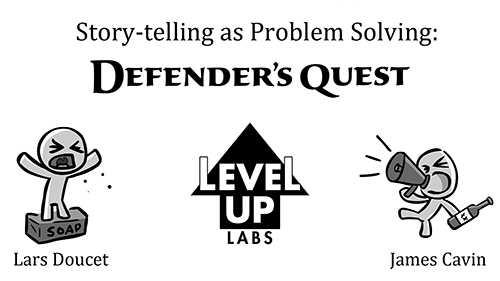
This talk has a very simple thesis: a game’s story absolutely must explain its mechanics.
Why? It’s a pretty simple answer - things are terrible when you don’t and much better when you do. Let me give you an example. This is an experience I had playing one of the bajillion 007 games that came out on the GameCube.
Here’s me as James Bond. I just picked up full body armor and a grenade launching shotgun. I just spent the last twenty minutes annihilating everything that moves in downtown Moscow. I am a bulletproof, Pierce Brosnan shaped angel of death.
Now I round a corner and am suddenly replaced by Cutscene Bond. Cutscene Bond enters the room and is confronted by this bad guy. “Stop right there, Mr. Bond,” commands the badguy,menacing Cutscene Bond with a pistol.
And instead of launching into one of the most laughably one-sided firefights in the history of the world, Cutscene Bond throws up his arms, because he has seemingly forgot that he has seventy pounds of body armor, a fully automatic incendiary grenade shotgun and also that this pistol is the crappiest weapon ever forged by hand of man, and in fact does less damage than if the villain were to simply point his finger and say bang.
I know these things because the last seven hours of gameplay have established these rules over and over and over. Body armor blocks damage. The wimp pistol does minimal damage. The grenade launcher outclasses every gun in the game. There is no way in which this scenario poses any threat to Bond. I know this. Apparently, Bond doesn’t. Which is why his game got traded to my friend for a box of Pokemon cards.
Now, it’s important to note here that this cutscene is not bad story. It feels entirely right for a James Bond setting. I mean, how many times have we seen that exact scene play out in a movie and it works just fine? So why is it that it’s super frustrating here?
Simply put, it’s because it broke every rule the game had taught me. Which is weird, because the gameplay is also totally right for the James Bond setting. I mean, how many times have we seen 007 use some crazy cool weapon to blast through dozens of enemies? It feels totally right. So how can it be that both the story and the gameplay feel totally right for 007 and yet are totally wrong for each other?
So how can it be that both the story and the gameplay feel totally right for 007 and yet are totally wrong for each other? The problem is that the Gameplay and the Story are drawing inspiration from the same source, but arriving at completely different and in fact totally incompatible conclusions.
The problem is that the Gameplay and the Story are drawing inspiration from the same source, but arriving at completely different and in fact totally incompatible conclusions.
A cutscene bullet and a gameplay bullet are two completely different entities. This in turn makes cutscene reality and gameplay reality completely different things.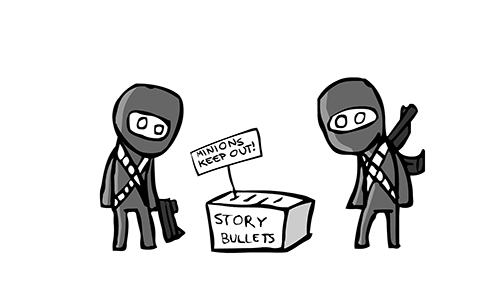
All of this could have easily been avoided if the writer had remembered the mechanics of
his own game. If the bad guy was sitting behind three feet of bullet proof glass and
pointing automated armor piercing laser turrets at me, it would have worked just fine.
Instead, Bond forgets the basic rules of the game he’s in, all because the Story team and the Gameplay team were operating in complete independence of each other.
After this experience I started seeing the same thing pop up again and again in games. Instead of writing a story that explains the mechanics of what the player is doing, Developers fall into the same trap: they pick a setting and then start developing a story that fits it and gameplay that fits it. Again and again we end up with weird conflicting elements just duct-taped together like angry cats.
This is a problem regardless of how good the individual parts are. For instance, Hamlet
is a phenomenal story... but a terrible tower defense game.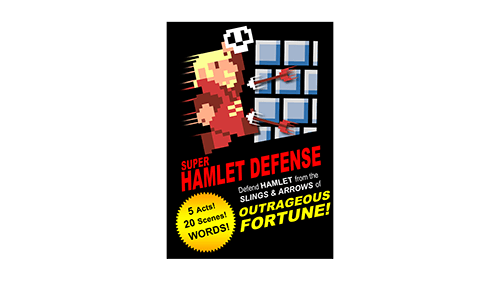
A lot of people hand wave these conflicts as just a natural part of games. It’s a
concession we have to make to our medium. Well I don’t think so. In fact, I think that if your story is written to explain your mechanics, not only will you minimize ludo-narrative dissonance, but you will also create more unique, nuanced and compelling stories.
but you will also create more unique, nuanced and compelling stories. To use a perennial example, let’s take a look at Final Fantasy 7.
To use a perennial example, let’s take a look at Final Fantasy 7.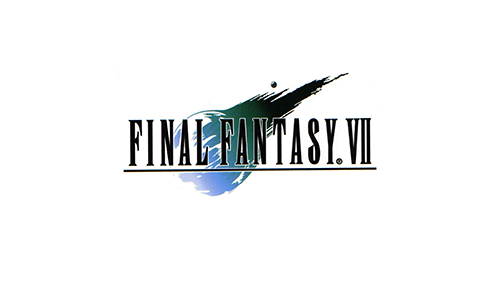
In possibly the most oft cited case of ludo-narrative dissonance, FF7 contains a plot point that straight up ignores the actual game. For hours upon hours the player has been taught that their characters can be killed in battle. Fortunately, it’s a fixable problem. The player can simply use an item called the phoenix down to literally resurrect these killed characters.
Fortunately, it’s a fixable problem. The player can simply use an item called the phoenix down to literally resurrect these killed characters. Then the plot kills one of your party members,
Then the plot kills one of your party members, and nobody thinks to use a phoenix down.
and nobody thinks to use a phoenix down.  This is a character that, for many players, has literally died and been resurrected multiple times in the past - we’ve been taught that death is no problem in the same way that James Bond’s gameplay taught us that the sissy pistol was no problem.
This is a character that, for many players, has literally died and been resurrected multiple times in the past - we’ve been taught that death is no problem in the same way that James Bond’s gameplay taught us that the sissy pistol was no problem.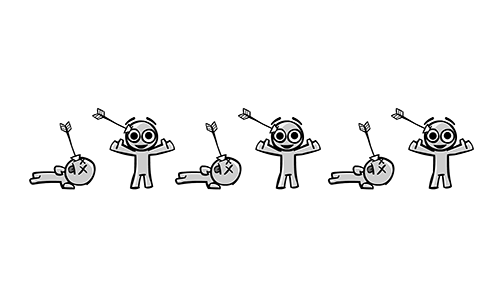 The huge problem here is that, unlike Bond, it’s not just this single plot point that contradicts the mechanics. The entire setting does. Gameplay has taught us that violent death is a solvable problem. For a few bucks that mangled corpse is right back and good as new! How does the entire world not revolve around this concept?
The huge problem here is that, unlike Bond, it’s not just this single plot point that contradicts the mechanics. The entire setting does. Gameplay has taught us that violent death is a solvable problem. For a few bucks that mangled corpse is right back and good as new! How does the entire world not revolve around this concept?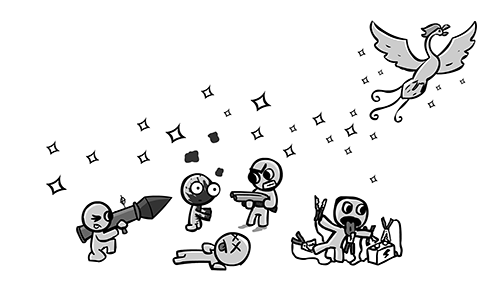
Where are the bloodsports? Where’s the dangerous jobs with no hazard pay? Where’s the crazy adrenaline junkies base jumping without parachutes just for the thrill of it?
Violence is literally of no consequence. What on earth would human culture look like in these conditions? That’s a world I want to explore.
If Final Fantasy 7 had tried to explain its mechanics, not only would it have avoided this
basic inconsistency, it could have been a groundbreaking piece of speculative fiction
with a setting completely unique in the games of its time.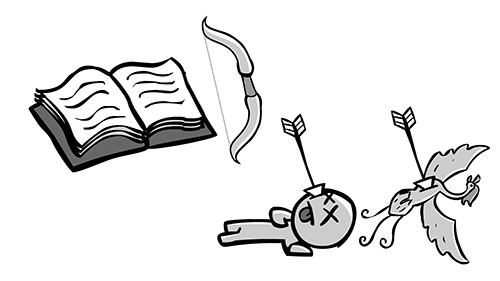 It's an incredible missed opportunity all because the writers didn't feel like connecting their story with the gameplay in any meaningful way. Once again, this is a problem that arises regardless of how good the writing and gameplay are in and of themselves.
It's an incredible missed opportunity all because the writers didn't feel like connecting their story with the gameplay in any meaningful way. Once again, this is a problem that arises regardless of how good the writing and gameplay are in and of themselves. Failing to give story justification for your mechanics will always put on the path to serious ludo-narrative dissonance and deprives you of interesting and unique story opportunities.
Failing to give story justification for your mechanics will always put on the path to serious ludo-narrative dissonance and deprives you of interesting and unique story opportunities.
When it came time to create our own game story, we wanted to avoid these pitfalls. While we weren’t perfect, I felt our system gave us a much better overall product than if we had just picked a theme and started writing. So, our goal was to have a story that justified our gameplay mechanics and explored their consequences on the world. We wanted to avoid ludo-narrative dissonance and seize any opportunities to explore the unique narrative consequences of our mechanics.
So, our goal was to have a story that justified our gameplay mechanics and explored their consequences on the world. We wanted to avoid ludo-narrative dissonance and seize any opportunities to explore the unique narrative consequences of our mechanics.
Before we had a single word of story written, we created a grand list of every mechanic we knew would be in the game. As a tower defense RPG hybrid, this was a lot of stuff. We looked at our huge master list and asked ourselves “What story would justify all these things in the simplest and most elegant manner?”
As a tower defense RPG hybrid, this was a lot of stuff. We looked at our huge master list and asked ourselves “What story would justify all these things in the simplest and most elegant manner?”
And boy, did we have a lot of mechanics to explain. Defender's Quest was going to be a tower defense RPG mash up. There would be something to defend,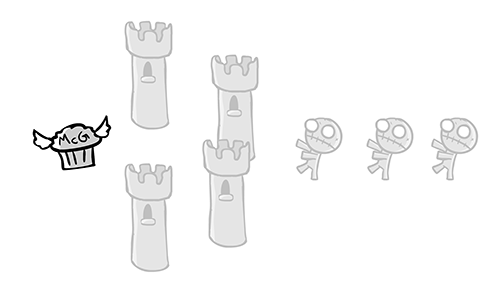
...and a horde of single-minded path, following enemies to defend it from. 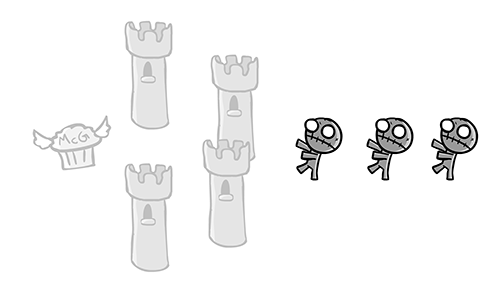
We borrowed the film term "mcguffin" to describe our arbitrary object to be defended because “arbitrary object to be defended” gets a little unwieldy over time.  So there's a mcguffin and enemies that want it. These enemies march onward towards their target along specific paths with no thought for their own safety or survival.
So there's a mcguffin and enemies that want it. These enemies march onward towards their target along specific paths with no thought for their own safety or survival.
The player defends against them by placing towers.  In our case, these towers were persistent RPG characters – they leveled up, gained new abilities, had equip-able gear that boosted their performance, etc.
In our case, these towers were persistent RPG characters – they leveled up, gained new abilities, had equip-able gear that boosted their performance, etc. 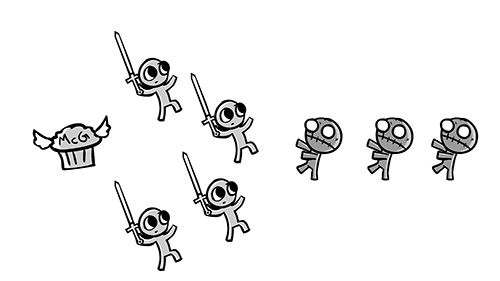 However, our defenders still had to function like towers – they were placed one at a time, appeared instantly out of nothing, couldn't move at all, and when they received too much damage they were removed from play. Removed characters could be re-summoned into the fight. And all of these actions cost the player some kind of currency that was gained by defeating enemies.
However, our defenders still had to function like towers – they were placed one at a time, appeared instantly out of nothing, couldn't move at all, and when they received too much damage they were removed from play. Removed characters could be re-summoned into the fight. And all of these actions cost the player some kind of currency that was gained by defeating enemies. And that was just the battle mechanics. Outside of battle, there would be an overworld to explore, new units to meet and recruit and shops with purchasable items.
And that was just the battle mechanics. Outside of battle, there would be an overworld to explore, new units to meet and recruit and shops with purchasable items.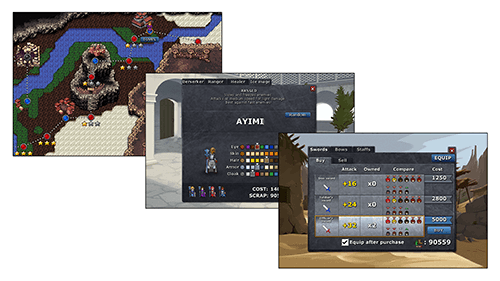 When we looked at this grand list of mechanics, we were immediately confronted by serious story problems.
When we looked at this grand list of mechanics, we were immediately confronted by serious story problems.
-
 What kind of enemy behaves in the way our tower defense creeps did?
What kind of enemy behaves in the way our tower defense creeps did? - What kind of currency comes from beating up bad guys? Why can I use it to summon my friends?
- For that matter, why do I have to summon my friends? Why aren't they here all the time? Also, why can't they move while they're here?
- What was the McGuffin? Why did the enemy want it?
- Why would characters want to join the player's party?
- Where did all these bad guys come from?
- What kind of world is full of hostile forces, but also shops brimming with useful gear?
- Why would the mcguffin ever have to move? If this is a defense game, why don't you just build yourself a castle?
 It became immediately apparent that no rational creature would ever behave in the way we needed our enemies to, so any story that required individual enemies to be human or other intelligent entities wouldn't work.
It became immediately apparent that no rational creature would ever behave in the way we needed our enemies to, so any story that required individual enemies to be human or other intelligent entities wouldn't work.In fact, the more we thought about it, the fewer things we found that would make any
kind of sense with a path following, no thought for survival, single-minded desire for the
mcguffin.
We finally settled on zombies – they met all of our criteria for enemy behavior: singleminded, travel in hordes, no thought for self preservation. They also provided a satisfying enemy to fight – smashing a zombie feels way cooler than smushing an ant, even though an ant would have also met our requirements. I do want to underscore something - zombies are admittedly a bit cliche, but we chose them because they were a story element that answered the questions our mechanics raised, not because, "Hey zombies would be cool."
So we had our enemy cast, but we still had a bunch more battle mechanics to answer. Why was it that currency was gained by killing zombies? And why could this currency be used to summon defenders?
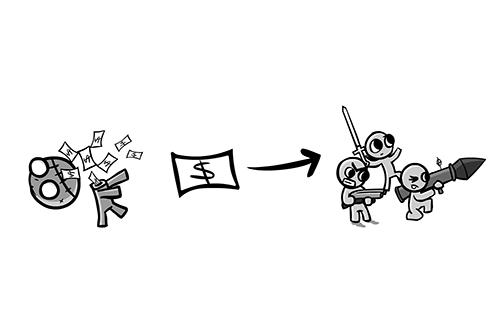
We started thinking about things that zombies would have that could also be used to power our summoning mechanic. The most elegant solution we could find was...magic. This meant that our zombies were no longer just Day of the Dead style infected corpses that could be stopped by destroying their brain. Now they were necromantic zombies driven by dark magic,
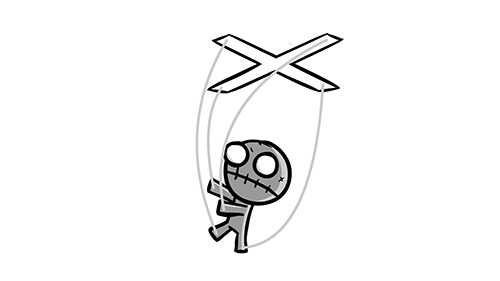 ...which could harvested when they were defeated.
...which could harvested when they were defeated.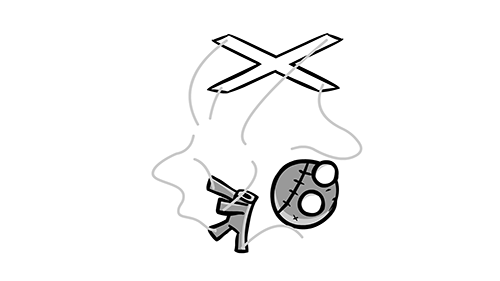 This approach already began developing the story for us: if these are magical zombies, where is the magic coming from? The basis for a necromancer villain had already been created.
This approach already began developing the story for us: if these are magical zombies, where is the magic coming from? The basis for a necromancer villain had already been created.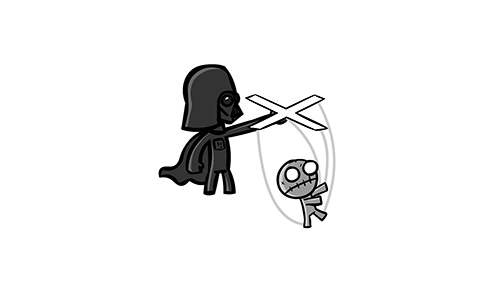 Next we had to answer why the player needed magic to summon friends, and why friends had to be summoned in the first place. Immediately we saw that this mechanic could not be explained in the real world. It would make no sense to be walking along with all of your friends, get attacked by zombies, and then suddenly it's tower defense time and you have to pay magic to place your buddies one by one when they were standing next to you just a second ago.
Next we had to answer why the player needed magic to summon friends, and why friends had to be summoned in the first place. Immediately we saw that this mechanic could not be explained in the real world. It would make no sense to be walking along with all of your friends, get attacked by zombies, and then suddenly it's tower defense time and you have to pay magic to place your buddies one by one when they were standing next to you just a second ago.The natural solution we found was to simply remove our battles from the real world. Yes, you and all your buddies are walking along, but when the zombies attack, you are suddenly pulled into the spirit world. Now you have to use magic to pull allies in with you.

Once again, this explanation started the ball rolling for other story points. Who's doing all this spirit world entering business? The groundwork was set for our protagonist – someone with ability to travel into the spirit world and bring others with them. The more we played around with this concept, the more we found it fit really well. Of course characters wouldn't be able to move in here – it takes our protagonist an incredible amount of concentration to bring them into it. And if they get hit too much, this concentration is broken and they get kicked out of the spirit world.
We then decided to make our spirit-world traveling protagonist and tower-defense mcguffin one and the same.
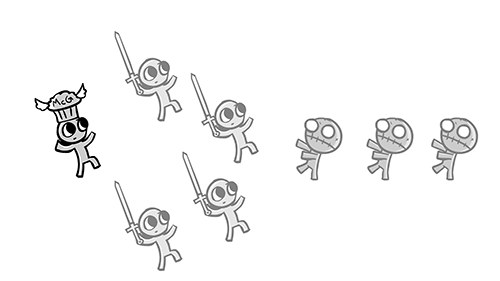
We still needed to answer the question of why people would want to join up with our protagonist. After all, if this person is constantly being hunted by zombies, being in there general vicinity is the last thing you want to do.
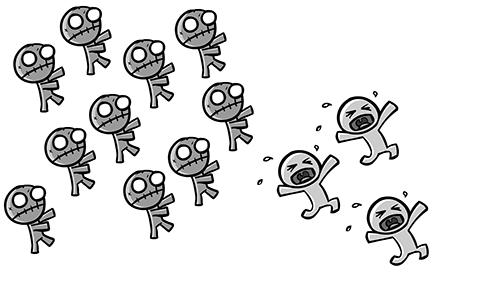 As it stood, the only people that would sign up for team Mcguffin were absolute altruists and that really doesn't make for an interesting set of characters. We wanted a diverse collection of heroes with varying and sometimes conflicting motivations that would fight and bicker and joke and feel like a collection of real people.
As it stood, the only people that would sign up for team Mcguffin were absolute altruists and that really doesn't make for an interesting set of characters. We wanted a diverse collection of heroes with varying and sometimes conflicting motivations that would fight and bicker and joke and feel like a collection of real people.So what unifying desire would cause all these people to work together for the mcguffin?
 What if the mcguffin was the only chance for escape from the zombie hordes? We've already established that the protagonist is in possession of incredibly rare if not unique abilities, so what if they are the only person that can do this? And what if that's the only way to kill zombies?
What if the mcguffin was the only chance for escape from the zombie hordes? We've already established that the protagonist is in possession of incredibly rare if not unique abilities, so what if they are the only person that can do this? And what if that's the only way to kill zombies?We've already established that our zombies aren't the shoot 'em in the head variety – they're magic. So what if the only way to kill them is to enter the spirit world and fight them on their own turf. And the only one that can do that is our mcguffin.

This made signing up for team mcguffin a little more of a logical step, but we felt that we
needed a little extra push to justify all the diverse character we wanted. Our solution was to make our setting a miserable place everyone wanted to escape from. Standing between them and escape is all of our hordes of zombies, so the only way out is to team up with the one person that can kill zombies.
So what setting would provide this kind of motivation?
How about a plague colony?
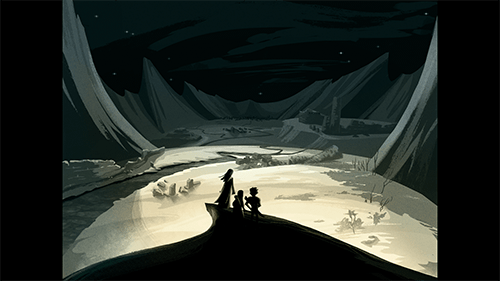
This actually answered a whole slew of our problems in one go. Everyone here is trapped because they've been cast out by the rest of society – there's a plague on and the risk of infection is too great to allow survivors back. So now all these people are trapped in this prison colony that's full of zombies. Why is a plague colony full of zombies? Well, because it's full of corpses – the perfect ammo for a necromancer to build an army. This handily explains the source of the hordes of enemies our mechanics required.
It also explained why our dangerous world provided just enough civilization to allow for the item shops we wanted – of course survivors would band together in small, defensible settlements and trade for weapons and gear.
 It also provided a motivation for the protagonist to move – you don't want to just turtle up and defend the mcguffin because you want to find an exit and get the heck out of this dump.
It also provided a motivation for the protagonist to move – you don't want to just turtle up and defend the mcguffin because you want to find an exit and get the heck out of this dump.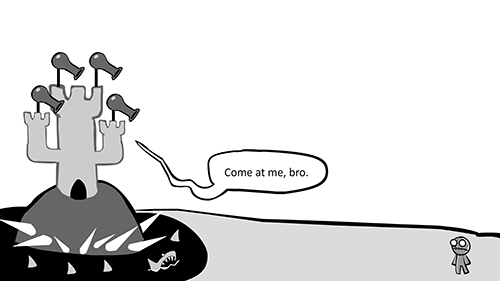
What felt amazing was that by answering all of these mechanics questions we had not only dodged ludo-narrative dissonance, we had also begun to create a setting far more compelling and unique than what we would have arrived at on our own.
A unique spirit walker wonders an apocalyptic plague colony in search of escape, while keeping one step ahead of a dark necromancer, hell bent on their capture for his own dark reasons.
We had unique zombies, an unusual world, a compelling protagonist with understandable motivations, a mysterious enemy all without writing a single word of story. From here I could begin my work as a writer, populating our world with interesting characters and compelling mystery.
Best of all, we could do it without fearing that story and gameplay would contradict
each other. It was a world that was founded on the rules of our game – meaning a bullet was always a bullet, in story and in gameplay.
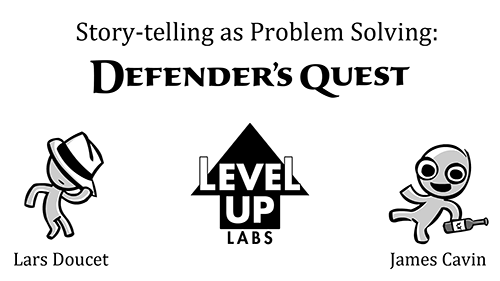
This is a companion discussion topic for the original entry at http://www.fortressofdoors.com/story-telling-as-problem-solving-defenders-quest-gdc-2013-narrative-summit/
